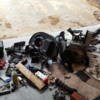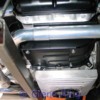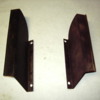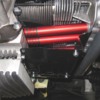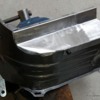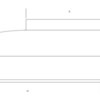Similar to VW Beetle aftermarket " Cool Tins" in appearance
There is no debate over at least needing the OEM square tin bit (there is another often missing 1" square piece on heads too)-


I am wondering if the 3 inch piece would also be attached with the type 3 tin...
Stop wondering and just stick to the correct T1 tins for you T1 motor...
What's the issue with T3 cooling tins? One would think that as the cars and engines matured, as with the boxy little type 3 bodies, that VW would have evolved the pancake cooling tins into something effective.
Sure, there was that BIG, crank-driven fan on the rear (totally uncool for any dune buggy application), but I can't remember any boxy type 3's with overheating problems.
...hehehe, an I jus' joined their group...hehehe
...and I got 'my fightin' already...
I would think (I may be wrong) that unless your going to use the complete set up (T1 or T3) you might be shorting your engines cooling.
With all the R&D VW put into air cooling, I've not heard of any T1's coming from the factory with T3 tins, but what the heck do I know...
I'm still trying to learn all this stuff and would like to know.
Bruce, Wanna play with tins~n~Temps?
Meade, it could be the PO's overheating could be due to poor timing, lack of carb sync and not paying attention to it etc...
crhemi (Bill) posted:I would think (I may be wrong) that unless your going to use the complete set up (T1 or T3) you might be shorting your engines cooling.
With all the R&D VW put into air cooling, I've not heard of any T1's coming from the factory with T3 tins, but what the heck do I know...
I'm still trying to learn all this stuff and would like to know.
Bruce, Wanna play with tins~n~Temps?
Meade, it could be the PO's overheating could be due to poor timing, lack of carb sync and not paying attention to it etc...
Bill's got a point. Get that motor to it's stock configuration with everything set to spec: valves, carbs, timing, etc. and see how the temps are. If it doesn't cool right, put the T3 tins on it. I might have avoided some expense if I had checked the timing before doing several other mods. I didn't and when I did my timing was WAY off which added to a heating issue.
I like the idea about the timing and the carb issues. But I've already got the engine down to the short block, so I think I'm going to go ahead and after I put the new piston set on, I'll try the type 3 tin.0. It's not that big of a deal, hahaha, to pull the engine and replaced it now that I know how to do it. I've done it on Volkswagens for about 30 years so I kind of know what goes where. On good days.
Meade
Proof of puddin'
Attachments
Attachments
Yeah, but how can you tell where everything is from all that disarray?
Gordon's shot looks like something from a certain Pink Floyd video.
Meade's..............Not so much.
THANKS!! Where is Pink Floyds?
...ever see baked oil? This is the bottom plate from my disassembled engine.
I guess the picture didn't come through. I will try it again.
Attachments
Looks like paint to me. You sure it's baked on oil?
The bubbles, and edges where it's peeled; I agree with Ted (TRP). That looks like paint.
Meade,
You mean, Which ones Pink?
In reference to Pink Floyd, the rock band, from their "Is there anybody out there" video starting at the 1:17 minute mark.
https://www.youtube.com/watch?v=Pr-JoqFVC5E
Jus sayin.
I thought paint also, but it was too thick. I took the picture after I scraped off the surface layer.
I chickened out and left the big tin off because I was getting so much different feedback. A big one was when I saw that someone had modified the tin and I wasn't knowledgeable enough to undertake that modification.
Meade
My opinion is for a Type 1 engine you should use Type 1 tin... not Type 3. The T3 fan blow across the cylinders while the T1 fan blow down.
I recommend using ALL the OE tin including the fan shroud. I simply do not trust any of the aftermarket shrouds. VW did extensive testing which the aftermarket just made cosmetic copies.
I have a 2180 with 9.5cr, all factory tin including the "Hoover Bit" and Type 126 "Industrial Tins" to close off the gap when deleted heater boxes. I'm using a stock Type 1 oil cooler added a 1.5qt sump and have a remote oil filter. Oil temps never exceed 215*F so there's no need for a secondary oil cooler.
Attachments
Mad Duck posted:I chickened out and left the big tin off because I was getting so much different feedback. A big one was when I saw that someone had modified the tin and I wasn't knowledgeable enough to undertake that modification.
Meade
Good call Meade. I think you'll be happier in the end that you made this choice.
Well, technically, the differences between a type 1 engine and a type 3 engine is mice nuts, except for the cooling. If you pulled all of the cooling tins off of both engines and looked at the long blocks, unless you had a lot of experience with AC VW engines you would be hard put to tell the differences. This was the last use of the type 1 casting before the Type 4 emerged in the 411/412 wagon and notchback and the 914.
VW came up with the flat-pack cooling so that the engine would fit under the back floor of the type 3 notchback and wagon. The fan sucks in, at the rear, just like the type 1 fan, and then clever ducting takes the air forward and up across the top of the cylinders and directs it down through the barrel fins, just like the type 1. It even has deflectors in the ducting to equalize airflow across all cylinders (better than the T-1 shroud does). The fan was slightly more efficient because it had to pull harder through the ducting from the sides of the car at the rear, then down and turned 90 degrees (twice) and into the fan inlet. Remember that the Type 3 was introduced to compete in the USA with higher powered cars at higher speeds and I don't recall hearing about Type 3 cooling problems. The type 3 died because VW went to water cooling to better meet tighter emissions requirements (the "Rabbit/Golf").
Anyway, me dos centavos says; What the hell.....Try the type 3 cooling tins. If I had some kicking around, I might try them just to see how they worked in a Speedster. My 2 cents would bet that they'e better than OK (but you would have to fab up a bracket for an alternator as all they ever had was generators).
Here's a type 3 with fuel injection:

And here's the long block with the horizontal oil cooler:

And here's a type 1 long block, with the upright cooler

Glenn mentioned something significant that some people may not be aware of- when leaving off heater boxes and using J tubes, VW had sheetmetal pieces (from industrial engines) to close off the sides so the spent cooling air still exited out the back of the underside of the engine and merged with the under the car airstream as intended. I'll post pics later, and I think I have some drawings with dimension to bend up your own.... Al
Al, I look forward to the pics and drawing
Google Industrial Type 1 and there's all kinds of info and pictures...
Good job Al!
Thanks, Bill. It was a lot of work looking for those pics in the Samba gallery, transfering them to my pictures file and then loading them here!![]()
I am really impressed !Does inclosure improve air flow and lower temperatures of the engine?
Is that $29. PER SIDE OR FOR THE PAIR?
crhemi (Bill) posted:Is that $29. PER SIDE OR FOR THE PAIR?
Not sure, a email to them will answer it.
Mad Duck posted:I am really impressed !Does inclosure improve air flow and lower temperatures of the engine?
Yes- Normally the heaterboxes keep the spent cooling air where it's supposed to be, and the industrial tins (when the heaterboxes are replaced with J tubes) keep the spent cooling air heading back and allow it to join the under the car airstream, which makes it easier for the fan to push more air through the cylinder and head fins. To quote Awesome Powdercoat- they also "prevent radiant heat from the #1 J tube from causing the thermostat to open prematurely and cold air from below the car from preventing the thermostat from opening at all"
Agreed.... unless you're smarter than the VW engineers it's best to use ALL OEM tin. The reason most don't know about these are they were only used on 73 VW Things which had a gas heater or Type 126 industrial engines that didn't have heater boxes.
It's also important that the engine tin is sealed to the body. If there are gaps, then hot air from the exhaust will be sucked in and the engine will run hot.


